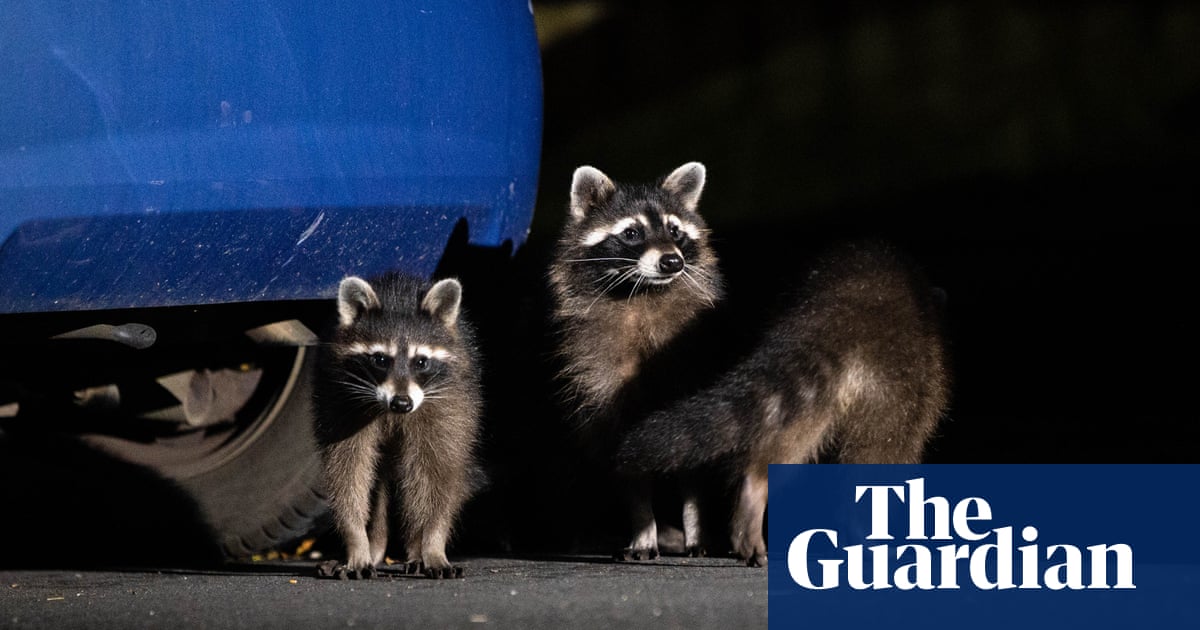In Kassel, everyone has a story about raccoons. Some struggle with a family of them that moved into their roof and simply will not leave. Others recount how a picnic in the park turned into an ambush as gangs of the black and white animals, known inGermanyasWaschbären,raided the food. Almost everyone seems to have a neighbour who feeds them, to the annoyance of the entire street.
“We are the raccoon city. They are everywhere,” says Lars, a Kassel resident, as he tends his allotment by Karlsaue park in the fading light.
“When it’s a bit darker, they will come out. I sit here in my garden at night and the raccoons come. If your bag is here, they will steal your banana or something,” he says. “They have no predators, so they are the chiefs. They can do what they want. We love them but we also hate them.”
While no one knows the exact number, there are thousands of raccoons in this central German city, a hotspot for the estimated 1.5 million that live across the country.
The omnivorous mammal, native to North America, was brought to Nazi Germany in the 1930s for fur farming, but escaping animals and intentional introductions helped establish a large wild population in the years afterwards. Today, they are increasingly spotted across Europe, withsightingsin France, Denmark, Poland, Italy, Austria and elsewhere.
“It is clear that the raccoon is spreading very rapidly across westernEurope,” says Daniel Willcox, a co-chair of the International Union for Conservation of Nature (IUCN) small carnivore specialist group. “It’s going to be very difficult to control – but it doesn’t mean you shouldn’t try.”
Many in Kassel have embraced the raccoons: several sports teams have named themselves after the animals; residential bins are locked to stop opportunistic raiders, and people are careful to check under their cars for the animals. But since 2016, the raccoon has been classified as an invasive species in the EU because of the threat it poses to native wildlife.
“The impacts of raccoons are widespread,” says Marten Winter, an invasive species expert at the German Centre for Integrative Biodiversity Research (iDiv). “They can climb, which is a totally new ecological niche for a species like this in Europe. Ground-nesting birds, bats in caves, birds in boxes, amphibians – they are able to eat almost everything.”
One studyin Brandenburg indicates that raccoons routinely predate on ground-nesting birds, which have already suffered significant population declines across the continent. Other research, from western Poland,shows they areeating “extreme” quantities of endangered mussels.
Raccoons have become so widespread in parts of Europe that they are now probably part of ecosystems for good, Winter says. Their spread across Europe is likely to accelerate and ecologists are divided about what to do next.
Willcox says: “There are certain native species that are going to be really sensitive to predation by raccoons. There have to be control programmes. There is no ecological equivalent to raccoons in Europe and it’s not something that should be tolerated.”
He proposes stricter programmes across the EU to limit their spread, akin to those in Australia andNew Zealandthat have invested large sumsto eliminate non-native biodiversity. But others urge caution. Winter says further research is needed about the raccoons’ impacts on European biodiversity and says they are not the only pressure on species they are accused of consuming.
“We need better data to really have an idea of the actual impact of the raccoon on its prey populations. With potentially 1.6 million individuals in Germany, they have an impact. But we still have the mink, which is also a very effective predator for ground-nesting animals. And what about cats? Cats are very likely to be causing more severe declines in bird populations, at least in semi-urban areas,” he says.
Despite the animal’s popularity among many Germans, 200,000 raccoons were culled last year alone. Hunting associations report that they are being found in growing numbers and across larger ranges. To help with population control,at least one butcherhas even started making sausages and meatballs from their meat.
“I’ve never had anyone say it is disgusting or that you can’t eat it. Honestly, everyone likes it,” he told CNN in 2024.
At sunset in Kassel, the stream of early summer cyclists begins to slow. Swallows and swifts feast on flying insects in the fading light. From the trees, raccoons begin to emerge, ready to scour the city in the short hours of darkness. Lars, resting on his spade, says Kassel’s residents will continue to embrace the animals – but there are limits.
“When I was a child, they were here but not so many,” he says. “They are a symbol for us here, a badge of honour. Sometimes, we are proud of them. But they destroy a lot.”
Find moreage of extinction coverage here, and follow the biodiversity reportersPhoebe WestonandPatrick Greenfieldin the Guardian app for more nature coverage
